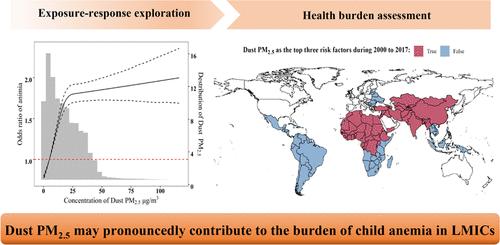当前位置:
X-MOL 学术
›
Environ. Sci. Technol.
›
论文详情
Our official English website, www.x-mol.net, welcomes your
feedback! (Note: you will need to create a separate account there.)
Burden of Child Anemia Attributable to Fine Particulate Matters Brought by Sand Dusts in Low- and Middle-Income Countries
Environmental Science & Technology ( IF 10.8 ) Pub Date : 2024-07-12 , DOI: 10.1021/acs.est.4c05305 Ning Kang 1 , Ruohan Wang 1 , Hong Lu 1 , Fred Onyai 2 , Mingjin Tang 3 , Mingkun Tong 1 , Xueqiu Ni 1 , Meiling Zhong 1 , Jianyu Deng 1 , Yanjun Dong 1 , Pengfei Li 4, 5 , Tong Zhu 6, 7 , Tao Xue 1, 5, 7
Environmental Science & Technology ( IF 10.8 ) Pub Date : 2024-07-12 , DOI: 10.1021/acs.est.4c05305 Ning Kang 1 , Ruohan Wang 1 , Hong Lu 1 , Fred Onyai 2 , Mingjin Tang 3 , Mingkun Tong 1 , Xueqiu Ni 1 , Meiling Zhong 1 , Jianyu Deng 1 , Yanjun Dong 1 , Pengfei Li 4, 5 , Tong Zhu 6, 7 , Tao Xue 1, 5, 7
Affiliation

|
Addressing environmental factors has recently been recommended to curb the growing trend of anemia in low- and middle-income countries (LMICs). Fine particulate matter (PM2.5) generated by dust storms were concentrated in place with a high prevalence of anemia. In a multicounty, multicenter study, we analyzed the association between anemia and life-course averaged exposure to dust PM2.5 among children aged <5 years based on 0.65 million records from 47 LMICs. In the fully adjusted mixed effects model, each 10 μg/m3 increase in life-course averaged exposure to dust PM2.5 was associated with a 9.3% increase in the odds of anemia. The estimated exposure–response association was nonlinear, with a greater effect of dust PM2.5 exposure seen at low concentrations. Applying this association, we found that, in 2017, among all children aged <5 years in the 125 LMICs, dust PM2.5 contributed to 37.98 million cases of anemia. Results indicated that dust PM2.5 contributed a heavier burden than all of the well-identified risk factors did, except for iron deficiency. Our study revealed that long-term exposure to dust PM2.5 can be a novel risk factor, pronouncedly contributed to the burden of child anemia in LMICs, affected by land degradations or arid climate.
中文翻译:

低收入和中等收入国家沙尘带来的细颗粒物导致儿童贫血的负担
最近建议解决环境因素,以遏制低收入和中等收入国家(LMIC)贫血的增长趋势。沙尘暴产生的细颗粒物(PM 2.5 )集中在贫血高发地区。在一项多县、多中心研究中,我们分析了 <5 岁儿童的贫血与一生中平均接触粉尘 PM 2.5之间的关联,id=123>3 一生中平均接触粉尘 PM 2.5的增加与 9.3% 的风险相关贫血的几率增加。估计的暴露-反应关联是非线性的,低浓度下粉尘 PM 2.5暴露的影响更大。应用这种关联,我们发现,2017 年,所有 <5 岁 id=126>2.5 岁的儿童中,有 3798 万例贫血病例。结果表明,PM 2.5粉尘造成的负担比所有已明确的风险因素(缺铁除外)都要重。我们的研究表明,长期接触 PM 2.5粉尘可能是一种新的风险因素,明显加重了受土地退化或干旱气候影响的中低收入国家儿童贫血的负担。
更新日期:2024-07-12
中文翻译:

低收入和中等收入国家沙尘带来的细颗粒物导致儿童贫血的负担
最近建议解决环境因素,以遏制低收入和中等收入国家(LMIC)贫血的增长趋势。沙尘暴产生的细颗粒物(PM 2.5 )集中在贫血高发地区。在一项多县、多中心研究中,我们分析了 <5 岁儿童的贫血与一生中平均接触粉尘 PM 2.5之间的关联,id=123>3 一生中平均接触粉尘 PM 2.5的增加与 9.3% 的风险相关贫血的几率增加。估计的暴露-反应关联是非线性的,低浓度下粉尘 PM 2.5暴露的影响更大。应用这种关联,我们发现,2017 年,所有 <5 岁 id=126>2.5 岁的儿童中,有 3798 万例贫血病例。结果表明,PM 2.5粉尘造成的负担比所有已明确的风险因素(缺铁除外)都要重。我们的研究表明,长期接触 PM 2.5粉尘可能是一种新的风险因素,明显加重了受土地退化或干旱气候影响的中低收入国家儿童贫血的负担。
















































 京公网安备 11010802027423号
京公网安备 11010802027423号